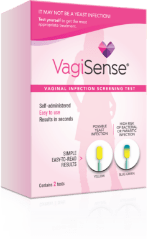Frequently asked questions

What would you like to know?

Vaginitis is a term for inflammation of the vagina, most commonly caused by an imbalance in vaginal bacteria. The three most common types of vaginal infections are yeast infections, bacterial vaginosis, and trichomoniasis. There are also non-infectious causes of vaginitis such as allergic reactions to vaginal sprays, douches, spermicidal products, soaps, or detergents.
BV can affect women of any age, but is most common in women during their reproductive years. A bacterial infection occurs when “harmful” bacteria outnumber the “good” bacteria that are normally found in a woman’s vagina. BV is the most common cause of bacterial discharge and odour.
A vaginal yeast infection is a common infection that is caused by a fungus called Candida. Candida is a naturally occurring yeast that is found in small amounts in a woman’s vagina. A yeast infection is the result of an increase in the quantity of Candida.
Trichomoniasis, also known as “trich,” is a sexually transmitted infection caused by a parasite. Although it is more commonly detected in women, both men and women can get a trich infection. In women, the infection can present itself in the vagina, urethra, cervix, bladder, and genital area glands.
A vaginal discharge is abnormal if the colour, smell, or consistency seem quite different than usual. The VagiSense® test can also be performed in cases of itching or irritation with normal vaginal discharge.
Vaginal pH refers to the acidity level of the vagina. Normal vaginal pH ranges between 3.8 and 4.5 (though this may vary slightly depending on your stage of life). A higher pH puts you at risk for vaginal infections. A vaginal pH of 4.5 or higher is a sign of bacterial vaginosis.
Yes. In one study, it was shown that 20% of the women with a yeast infection actually had mixed infections (a combination of yeast infection and bacterial infection and/or trichomoniasis).*
Yes. Showering before use will not affect the results; however, make sure you are completely dry before using the test as water may interfere with the test result.
VagiSense® reacts to vaginal secretion, which discharges throughout the day; therefore, you can test anytime.
VagiSense® should be used if you have any of the following symptoms: 1) abnormal or excessive vaginal discharge, 2) vaginal itching or vaginal burning, and/or 3) vaginal discharge with abnormal colour or unpleasant odour.
The test can also be used if you have itching or burning with normal discharge.
Delay the test if it is less than one day before or the day after your period, if there are signs of menstruation or any vaginal bleeding, if it is less than 12 hours after sexual intercourse or vaginal douching, and/or if it is less than 72 hours after the application of vaginal preparations like contraceptive creams or lubricants.
VagiSense® should be stored in a dry place at room temperature and out of reach of children. The test must be sealed until use to avoid contamination.
The VagiSense® box includes two test swabs for your convenience. Check the expiration date on the individual test package before using the product.
VagiSense® is an over-the-counter test, meaning it does not require a prescription.
You should follow the instructions indicated on the package insert.
You should wait 10 seconds and check the tip of the VagiSense® swab for colour changes from yellow to blue or green. You can then dispose of the test as you would any other feminine hygiene product.
If any part of the test tip is stained blue or green, your vaginal acidity (pH) is abnormal and you may have a bacterial or parasitic vaginal infection. You should talk to your doctor or pharmacist about your treatment options.
VagiSense® tests your vaginal discharge and indicates whether your vaginal acidity is normal or abnormal.
A positive test indicates a possible acidity imbalance in your vaginal secretion, known to accompany bacteria (bacterial vaginosis) and parasitic (trichomoniasis) infections.
Yes. VagiSense® can be used if you have itching or burning but your vaginal discharge is normal.
If the entire tip remains yellow after 10 seconds (negative result), it means that it’s unlikely you have a bacterial or parasitic infection. You may have a yeast infection, and you may consider using a non-prescription treatment.
You should perform a second test immediately after the first using a new VagiSense® swab.
If you are pregnant, you should consult your healthcare professional before using VagiSense® and never try to treat yourself before discussing your symptoms with your healthcare professional.
No results
*Ferris DG, Nyirjesy P, Sobel JD, et al. Over-the-counter antifungal drug misuse associated with patient-diagnosed vulvovaginal candidiasis. Obstet Gynecol. 2002;99(3):419–425.